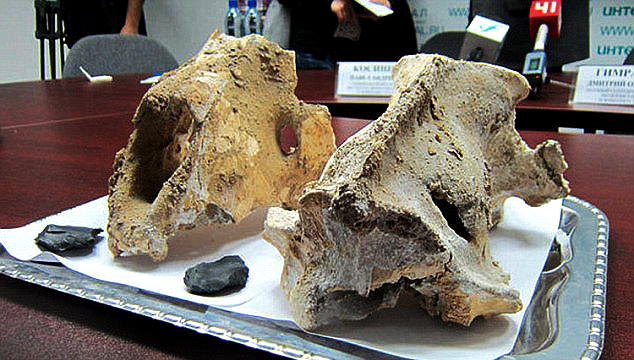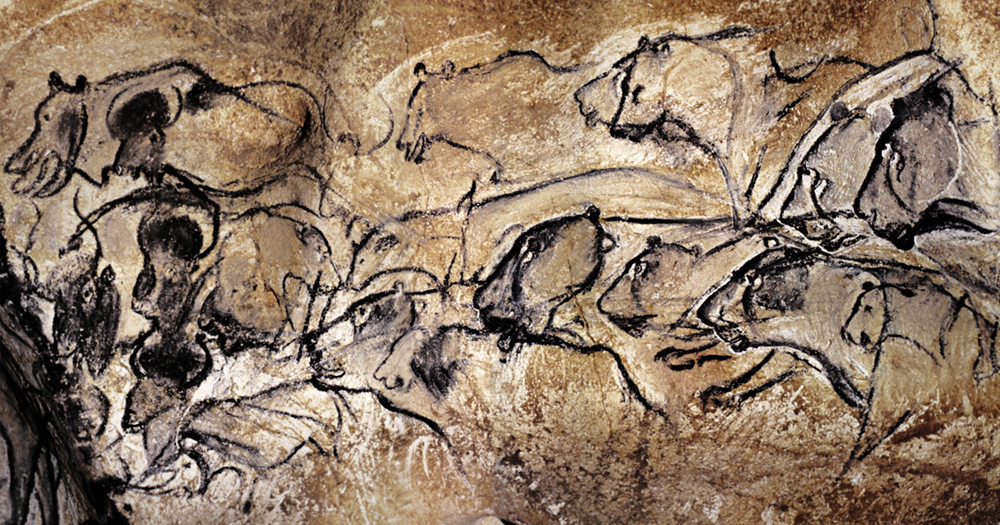


An article by Will Stewart for MailOnline - Sacred cave where giant lions were sacrificed 60,000 years ago discovered in Russia - reports on the recent discovery of ancient bones found inside Imanai cave in the Ural Mountains. The 500 bones and fragments are believed to have belonged to cave lions, animals approximately 25% larger than today's lions. Researchers have postulated that the artefacts, thought to be 60,000 years old, represent a form of sacrifice.

Lion skulls of the recent discovery
The cave lion - Panthera leo spelea and also known as the Eurasian cave lion - lived in and around Europe from roughly 370,000 to 12,500 years ago during the Pleistocene epoch. It evolved from the earlier Panthera leo fossilis, which first appeared in Europe about 700,000 years ago. Genetic evidence indicates this lineage was isolated from extant lions after its dispersal to Europe. It became extinct as the Wurm glaciation receded.

The discovery of artefacts from the Imanai cave is inevitably leading to comparisons with the cave paintings of the lions in Chauvet.
The bones of five or six lions were covered in layers of soil within the cave. The research is being led by Pavel Kosintsev, from the regional Institute of Plant and Animal Ecology in Yekaterinburg, who states that such a large quantity of cave lion bones at one site is unique.
At the same site, Russian researchers have discovered a cave bear skull pierced with an ancient spear. Numerous Mousterian stone spearheads have also been excavated.
As the cave was not inhabited, Pavel Kosintsev believes the artefacts found within represent a form of sacrifice.
Archaeologists will resume work in the summer next year.
View the Lions of Chauvet:
by Bradshaw Foundation
Monday 04 December 2023
by Bradshaw Foundation
Friday 30 June 2023
by Bradshaw Foundation
Thursday 06 April 2023
by Bradshaw Foundation
Thursday 24 November 2022
by Bradshaw Foundation
Tuesday 27 September 2022
by Bradshaw Foundation
Thursday 08 September 2022
by Bradshaw Foundation
Tuesday 19 July 2022
by Bradshaw Foundation
Monday 06 June 2022
by Bradshaw Foundation
Friday 11 March 2022
by Bradshaw Foundation
Wednesday 02 March 2022
by Bradshaw Foundation
Thursday 26 August 2021
by Bradshaw Foundation
Monday 16 August 2021
by Bradshaw Foundation
Tuesday 06 July 2021
by Bradshaw Foundation
Thursday 06 May 2021
by Bradshaw Foundation
Thursday 06 May 2021
by Bradshaw Foundation
Tuesday 16 March 2021
by Bradshaw Foundation
Monday 04 December 2023
by Bradshaw Foundation
Friday 30 June 2023
by Bradshaw Foundation
Thursday 06 April 2023
by Bradshaw Foundation
Thursday 24 November 2022
by Bradshaw Foundation
Tuesday 27 September 2022
by Bradshaw Foundation
Thursday 08 September 2022
by Bradshaw Foundation
Tuesday 19 July 2022
by Bradshaw Foundation
Monday 06 June 2022
by Bradshaw Foundation
Friday 11 March 2022
by Bradshaw Foundation
Wednesday 02 March 2022
by Bradshaw Foundation
Thursday 26 August 2021
by Bradshaw Foundation
Monday 16 August 2021
by Bradshaw Foundation
Tuesday 06 July 2021
by Bradshaw Foundation
Thursday 06 May 2021
by Bradshaw Foundation
Thursday 06 May 2021
by Bradshaw Foundation
Tuesday 16 March 2021
Friend of the Foundation











